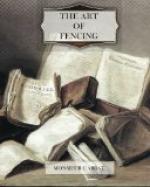In Order to chuse a good Blade, three Things are to be observed: First, that the Blade have no Flaw in it, especially across, it being more dangerous so than Length-way. Secondly, That it be well tempered, which you’ll know by bending it against a Wall or other Place; if it bend only towards the Point, ’tis faulty, but if it bend in a semicircular Manner, and the Blade spring back to its Straitness, ’tis a good Sign; If it remains bent it is a Fault, tho’ not so great as if it did not bend at all; for a Blade that bends being of a soft Temper, seldom breaks; but a stiff One being hard tempered is easily broke. The third Observation is to be made by breaking the Point, and if the Part broken be of a grey Colour, the Steel is good; if it be white ’tis not: Or you may strike the Blade with a Key or other Piece of Iron, and if he gives a clear Sound, there is no hidden Fault in it. In bending a Blade you must not force it, what I have said being sufficient to know it by, and besides by forcing it, it may be so weakened in some Part as to break when it comes to be used.
It would not be amiss for a Man to see his Sword mounted, because the Cutlers, to save themselves the Trouble of filing the inside of the hilts and pommel, to make the Holes wider, often file the Tongue[1] of the Blade too much, and fill up the Vacancies with Bits of Wood, by which Means the Sword is not firm in the Hand, and the tongue being thin and weak, is apt to break in Parrying or on a dry Beat, as has been unhappily experienced. Care should also be taken that the End of the Tongue be well riveted to the Extremity of the Pommel, lest the Grip should fly off, which would be of very dangerous Consequence.
Some Men chuse strait Blades, others will have them bending a little upwards or downwards; some like them to bend a little in the Fort, and others in the Feeble, which is commonly called le Tour de Breteur, or the Bullie’s Blade. The Shell should be proportionable in Bigness to the Blade, and of a Metal that will resist a Point, and the Handle fitted to the Hand.
Some like square Handles, and others chuse round Ones; the square are better and firmer in the Hand, but as this Difference depends on Fancy, as does also the Bow, which in some Cases may preserve the Hand, but may be a Hindrance in inclosing, I shall leave it to the Decision of the Fashions.
CHAP. II.
Of Guard.
By Guard, is meant such a Situation of all the Parts of the Body as enables them to give their mutual Assistance to defend or attack. A Guard cannot be perfect without a good and graceful Disposition, proceeding from a natural Proportion of the Parts of the Body, and an easy and vigorous Motion, which is to be acquired by Practice, and the Instruction of a good Master.
[Illustration: Plate 1. The middling Guard.]
[Illustration: The straight Guard or flat Sword.]




